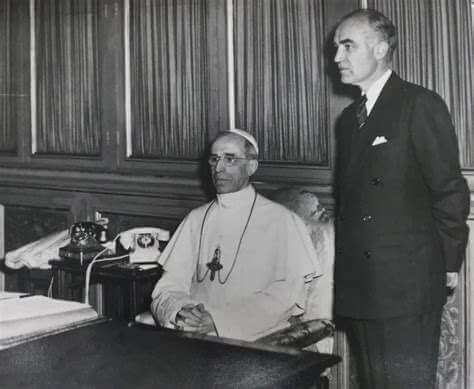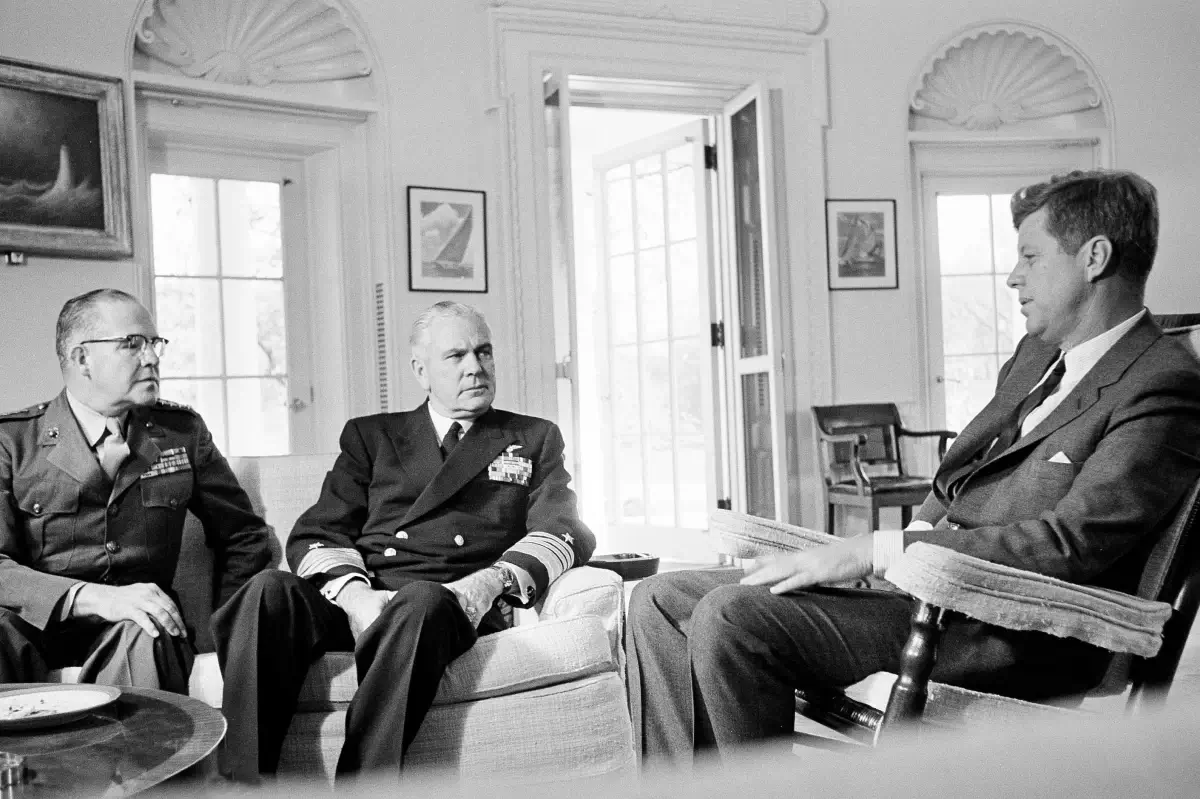Above: US government officials with Catholic president John F. Kennedy.
Before he died, Robert Blair Kaiser, Time magazine reporter at the Vatican II Council, told me that the reporters were “participant-observers to influence the schemas.” This was part of a worldwide assault on Catholic doctrine, noticed years before, and Vatican II provided an opportunity for the American “deep state” and “globalists” to place the Catholic Church in their service. The Council was occurring within about 17 years after the end of the bloodiest war in history and that war was vivid in the minds of many participants. At the same time, the world was locked in the Cold War, a titanic struggle between two different world views – one represented by Soviet Communism and the other by America. The former was depicted as dark and foreboding, the latter as light and prosperous. The American media helped to paint that picture.
Time magazine was the creation of Henry Robinson Luce. Luce was the son of a Presbyterian minister and could trace his lineage back to the American Revolution. He invented the newsmagazine with the founding of Time. With the mentoring of Walter Lippmann, Luce put into practice the emerging science and systemization of psychological manipulation which used images, words, and emotions to shape, form, and influence views, ideas, and perceptions both in the United States and overseas. Luce’s magazines made him one of the most powerful and influential men in America, and eventually the world. It is said that there was not a day that he did not speak of the United States Constitution which came to represent the political manifestation of the organizing principles of American society, or in other words, the American ideology. At the heart of this ideology were the tenets of the First Amendment.
Luce long had his eye on the Catholic Church with its doctrine of church and state. The Church was both an obstacle to the designs of the plutocratic interests to rule America and the world, and at the same time an opportunity to facilitate that objective of greater power and control. Luce shared the sentiments of Paul Blanshard, whose book American Freedom and Catholic Power became the bible of anti-Catholic liberals. Blanshard observed that the priest was the “agent for Roman spiritual and political goods” and “is subordinate to the hierarchy.”[1] The priest lent credibility to any idea, and a priest who was a theologian was even more of an authority. Blanshard understood the role of theology in helping the Church maintain its power. According to Blanshard,
The Church’s philosophy of church and state is far more important than the continued existence of a bit of acreage which has its own postage stamps and flag. In fact, the philosophy of church and state espoused by the Vatican is the most important thing in the whole Catholic system because it determines the political and social policies which the bishops and priests will pursue throughout the world.[2]
So, Luce and the socio-economic elites whose interests he advanced, needed a theologian to espouse approval of the American system of social organization. The American elites wanted the Church to approve the First Amendment with its Establishment Clause that disestablished any religion as the basis of the laws of a society, and that gave real power to the private interests with the free speech and free press clauses. That theologian would be John Courtney Murray, SJ, a professor at Woodstock College and editor of Theological Studies.
A secret meeting was held on April 26, 1948 at the Biltmore Hotel in New York City, and hosted by the National Conference of Christians and Jews.[3] Representatives were present from Protestantism, Judaism and Catholicism. The main issue was the relation of church and state. Murray agreed there was a problem. When it came to church-state relations, Catholicism was the problem, not America, or as he later put it: “the Church-State problem is, in the very specific and unique sense, a Catholic problem – a Roman Catholic problem.”[4] By agreeing to provide “a more liberal interpretation” of Catholic doctrine on church and state relations, Murray embarked upon an enterprise that would eventually weaken in the minds of many Catholic leaders one of the most important doctrines of the Catholic Faith.

Not long after, the United States Government, under the leadership of Dr. Edward Lilly, a wealthy Catholic professor at the Catholic University of America, devised a program of doctrinal warfare. Doctrinal warfare was considered “the central core of psychological warfare. Ideological or doctrinal warfare” involved a “planned attack against the basic hostile system conducted concurrently with a positive advocacy of basic ideas of our own system.”[5] Doctrinal warfare, in other words, was a way to reorder societies. Doctrinal warfare was not directed at “influencing mass behavior; in fact it is not immediately aimed at the masses, but at the decision makers and their staffs.”[6] It targeted the “developed mind. This mind, engaged in developing concepts and rationalizations and capable of projecting the same to others, possess the ability to clarify, analyze and synthesize” and one that would become “unsatisfied with their accepted ideology.”[7]
By 1953, the plan was developed and contained in the classified document known as PSB D-33. The doctrinal warfare program would seek to provide “permanent literature” and foster “long-term intellectual movements, which will appeal to intellectuals, including scholars and opinion-forming groups, to: (1) break down world-wide doctrinaire thought patterns which have provided an intellectual basis for Communism and other doctrines hostile to American and Free World objectives.”[8] To do this, it would “Exploit local divergencies, heresies or policy disagreements within opposition systems.”[9] The Government intelligence agencies were to coordinate their efforts with the media and corporations.
This was in time to help implement the plans for what we know today to be globalization. In 1952 and 1954 representatives of industry, banking, labor unions, intelligence agencies, federal government agencies such as the State Department, and others officially met unofficially at Princeton, New Jersey to discuss plans for making that happen.[10] American culture and ideas had to be inserted into societies so as to open the way for their economic development, or as some may say, economic colonization.
With the death of Pope Pius XII in October, 1958, and calling of the Council by his successor, John XXIII, the American elites sensed opportunity to expand their power by turning the Catholic Church into a purveyor of American ideas and policies, most notably the ideas behind the First Amendment. Luce and his entourage already knew that changes were afoot in the Vatican before that time, as they had great intelligence of the happenings in the headquarters of the Catholic Church. For example, he and the American establishment, as well as US intelligence agencies, funded and supported Pro Deo University and its founder, Fr. Felix Morlion, OP. This institution of higher education was in Rome and taught young businessmen and other professionals from around the Catholic world of the benefits of the American system of social organization. Indeed, it was there in November, 1953 that Luce delivered his speech, “The American Proposition.” Written by Murray, the speech as delivered by Luce advocated for the First Amendment as the ideal of social organization. Essential to that ideal was the Establishment Clause which disestablished the Catholic Church and the Catholic religion (as well as any church or any religion) from society. This clause, with free speech and free press, gave real power in society, the culture, and even over the religions, to the powerful private interests, or the plutocratic class.

In the Summer of 1962, just weeks before the start of the Council, Luce sent his chief lieutenant, Charles Douglas Jackson (“CD Jackson”), to Rome to investigate. Jackson had a history of working with media, intelligence agencies, and industry. He was a central figure in the confluence of the activities and interests of these three groups and also served as President Dwight Eisenhower’s speech writer. Jackson, privy to the internal workings of the hierarchy, remarked how the Church, “that tremendous mechanism all over the world,”[11] had to change to adapt to modern times.
Note: My book, John Courtney Murray, Time/Life and the American Proposition, explains the psychological and doctrinal warfare waged in the early stages of the Cold War against the Catholic leadership in an attempt to change Catholic doctrine, especially as to the proper relations between church and state. Catholic doctrine did not change, but there was fashioned a rhetorical and ideological weapon known as “the spirit of Vatican II” that has been used to distort Vatican II, mutilate Catholic doctrine, and bring confusion and suffering to many. More than seven years in the making with hundreds of footnotes from a multitude of sources, this two volume new edition with a forward by Dr. John C. Rao may be found on amazon.com in either paperback or e-version.
[1] Paul Blanshard, American Freedom and Catholic Power, (Boston: Beacon Press, 1949), 34.
[2] Ibid., 44.
[3] David Wemhoff, John Courtney Murray, Time/Life and the American Proposition (South Bend, IN: Wagon Wheel Press, 2022), Vol. I, 93-97.
[4] Untitled text of talk by John Courtney Murray that begins with “Mr. Chairman, Ladies and Gentlemen,” John Courtney Murray Papers, Box 6 File 445, Georgetown University Library, Special Collections Division, Washington, DC.
[5]“Terms of Reference, Ideological Warfare Panel,” OCB Secretariat Series Box 2 Folder “Doctrinal Warfare (Official) (File # 1) (4),” Dwight D. Eisenhower Library, Abilene, Kansas.
[6]“Statement on Doctrinal Warfare Targets,” dated February 6, 1953, OCB Secretariat Series Box 2 Folder “Doctrinal Warfare (Official) (File # 2) (2),” Dwight D. Eisenhower Library, Abilene, Kansas.
[7] Ibid.
[8] PSB D-33 June 29, 1953, “U.S. Doctrinal Program”, Psychological Strategy Board, Dwight D. Eisenhower Library, Abilene, Kansas.
[9] Ibid.
[10] Wemhoff, John Courtney Murray, Time/Life, and the American Proposition, Vol. I, 469-480.
[11] C.D. Jackson, “Overseas Report (Confidential) # 4 from CD Jackson,” dated August 7, 1962, CD Jackson Papers, Box 109, “World Trip, Transcripts, Italy, 1962,” Dwight D. Eisenhower Library, Abilene, Kansas.


